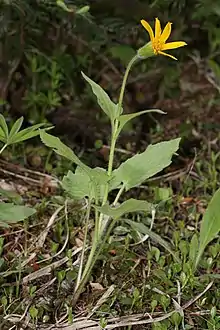Arnica cordifolia
Arnica cordifolia is a species of arnica in the sunflower family, known by the common name heartleaf arnica.[2] It is native to western North America.
| Arnica cordifolia | |
|---|---|
 | |
| Wenatchee Mountains, Washington | |
| Scientific classification | |
| Kingdom: | Plantae |
| Clade: | Tracheophytes |
| Clade: | Angiosperms |
| Clade: | Eudicots |
| Clade: | Asterids |
| Order: | Asterales |
| Family: | Asteraceae |
| Genus: | Arnica |
| Species: | A. cordifolia |
| Binomial name | |
| Arnica cordifolia | |
| Synonyms | |
|
Synonymy
| |
Description
This is a rhizomatous perennial herb producing one or more erect stems reaching a maximum height of about 60 centimetres (2 feet).[3] It has two to four pairs of leaves on the stem, each on a long petiole. The leaves are heart-shaped to arrowhead-shaped and finely toothed along the edges. The inflorescence bears one or more daisylike flower heads 5–9 cm (2–3+1⁄2 inches) in width,[3] lined with white-haired phyllaries and sometimes studded with resin glands. The center of each head contains golden yellow disc florets and a fringe of 10–15 bright golden ray florets approaching 3 cm (1+1⁄4 in) in maximum length.[3][4][5][6][7] The flowers usually bloom from April to June, but sometimes do so as late as September.[3]
The fruit is a hairy achene up to 1 cm (1⁄2 in) long, not counting its off-white pappus. Seeds are dispersed on the wind. An individual plant can live 12 years, surviving periodic wildfire by resprouting from its long, slender rhizome afterward.[7][8]
The species could be confused with the similar Arnica latifolia, from which it can be distinguished by the leaves. The leaves of A. cordifolia are larger and heart-shaped.[9]
Distribution and habitat
It is native to western North America from Alaska to California to New Mexico, as far east as Ontario and Michigan.[10][11] It is a plant of many habitat types, including coniferous forests, and moist mountain meadows from sea level to altitudes of above 3,700 metres (12,000 ft), but most commonly between 1,200–3,400 m (4,000–11,000 ft).[10][7]
Uses
The dried leaves can be made into a poultice or tincture to treat strains and bruises.[12]
References
- The International Plant Names Index
- Calflora taxon report, University of California, Arnica cordifolia Hook. heart leaved arnica, heartleaf arnica
- Spellenberg, Richard (2001) [1979]. National Audubon Society Field Guide to North American Wildflowers: Western Region (rev ed.). Knopf. p. 355. ISBN 978-0-375-40233-3.
- Klinkenberg, Brian, ed. (2017). "Arnica cordifolia". E-Flora BC: Electronic Atlas of the Plants of British Columbia [eflora.bc.ca]. Lab for Advanced Spatial Analysis, Department of Geography, University of British Columbia, Vancouver. Retrieved 2019-09-15.
- Giblin, David, ed. (2018). "Arnica cordifolia". WTU Herbarium Image Collection. Burke Museum, University of Washington. Retrieved 2019-09-15.
- "Arnica cordifolia". in Jepson Flora Project (eds.) Jepson eFlora. Jepson Herbarium; University of California, Berkeley. 2018. Retrieved 2019-09-15.
- Flora of North America Vol. 21 Page 374 Heartleaf arnica, Arnica cordifolia Hooker, Fl. Bor.-Amer. 1: 331. 1834.
- Ecology Fire Ecology
- Reiner, Ralph E. (1969). Introducing the Flowering Beauty of Glacier National Park and the Majestic High Rockies. Glacier Park, Inc. p. 44.
- Sullivan, Steven. K. (2018). "Arnica cordifolia". Wildflower Search. Retrieved 2019-09-15.
- Biota of North America Program 2014 state-level distribution map
- Fagan, Damian (2019). Wildflowers of Oregon: A Field Guide to Over 400 Wildflowers, Trees, and Shrubs of the Coast, Cascades, and High Desert. Guilford, CT: FalconGuides. p. 101. ISBN 1-4930-3633-5. OCLC 1073035766.
External links
 Media related to Arnica cordifolia at Wikimedia Commons
Media related to Arnica cordifolia at Wikimedia Commons- Jepson Manual Treatment
- Calphotos Photo gallery, University of California
